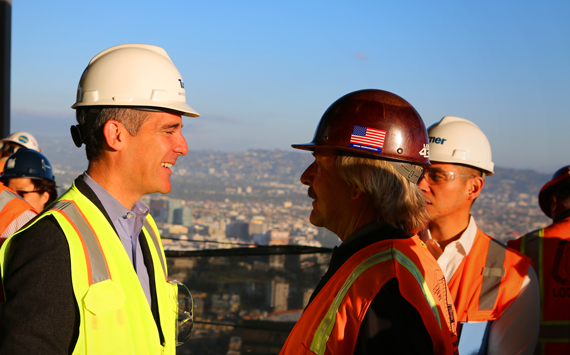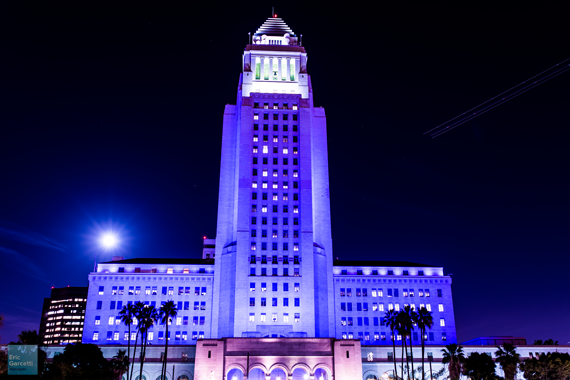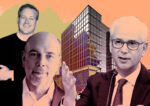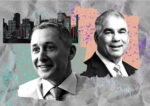Trending
Mayor Eric Garcetti and the building boom

From the L.A. print issue: Los Angeles Mayor Eric Garcetti has appeared with Jay Z to promote an open-air music festival, lit the façade of City Hall in purple to mark the death of Prince, and recorded an R&B video — the “101 Slow Jam” — to publicize the temporary closure of an overpass.
Yet the so-called “hipster mayor” has also made a name for himself as a budget cutter, a technocrat in the mold of former New York City Mayor Michael Bloomberg and a booster for new development.
Real estate professionals confirm that the development process has been more efficient under the mayor’s leadership. Among the key changes industry insiders point to is the parallel design permitting process, implemented just a few months after he took office in 2013. This policy allows developers to design projects and consult with the Building Department simultaneously. Christopher Martin, the architect behind the Wilshire Grand tower, told TRD that this single change had streamlined the planning process and “put it into a form that’s user-friendly and attractive to investors.”
But the mayor doesn’t intend to stop there. He wants to rip up the city’s zoning rulebook — the beating heart that sustains urban development — in order to facilitate more housing construction. He has called L.A.’s 35 community plans and the general plan outdated (no argument from developers, there) and created a program to overhaul them in the next decade.
Garcetti, a fourth-generation Angeleno, grew up in the inner circles of local Democratic Party operatives — his father, Gil Garcetti, is a former district attorney. He rose to power early. Fresh from Columbia University and a Rhodes scholarship from Oxford, he joined the City Council at 30. He was elected mayor at 42, one of the youngest mayors ever to lead the nation’s second-largest city.
As he was climbing the government ladder, he took on the issue of neighborhood beautification. As a City Council member representing L.A.’s District 13, he created UNTAG (Uniting Neighborhoods to Abolish Graffiti), a program that is credited with dramatically reducing graffiti in his district.
He burnished his credentials as an environmentally aware politician by appearing as a proponent of the electric car in the star-studded 2006 documentary “Who Killed the Electric Car?” Closer to home, he authored Proposition O, a 2004 stormwater initiative to fund projects that prevent the pollution of regional waterways.
 As a stalwart pragmatist, Garcetti now says that moving the city forward isn’t about environmental policy or economic policy, but about cooperation. Yet some critics argue that he’s bending too far in the direction of high-density development — although he’s widely viewed as a liberal Democrat — and some progressives are pushing back through the ballot box.
As a stalwart pragmatist, Garcetti now says that moving the city forward isn’t about environmental policy or economic policy, but about cooperation. Yet some critics argue that he’s bending too far in the direction of high-density development — although he’s widely viewed as a liberal Democrat — and some progressives are pushing back through the ballot box.
Two initiatives that could potentially shake up the development process by putting new restrictions on large-scale projects are heading to voters. The Build Better L.A. initiative would require more affordable housing in large multi-family projects, while the Neighborhood Integrity Initiative would mandate a two-year pause on projects requiring zoning amendments.
TRD asked the mayor what he thought about these initiatives, as well as a slew of other questions — some of which he answered, some of which he did not.
Following are the emailed responses TRD received from the mayor’s office at the end of August.
During your tenure, many of L.A.’s biggest commercial development projects ever have broken ground. What is your goal?
I’ve laid out an ambitious goal of building 100,000 new housing units by 2021 and doubling the production of affordable housing for low-income Angelenos.
Building enough housing to meet our needs is key to helping us address this crisis, as we protect the unique character of our neighborhoods. One way we do this is by concentrating development where it makes the most sense. That’s why I’m committed to creating more housing around our transit hubs. In 2015, 67 percent of new housing units permitted in the City were within 1,500 feet of high quality transit stops. Our Metro rail system is in the midst of an historic expansion, and we should be leveraging that growth to ensure we are bringing housing to key corridors.
What is your position on the Build Better L.A. initiative and the Neighborhood Integrity Initiative? The backers of the latter said they’d halt their campaign if you were to ban private meetings between real estate developers and officials.
I have heard their concerns. My office is addressing most of what is being raised, already leading one of the City’s most ambitious efforts to reform the development process in L.A.
Almost six months ago, the City announced an aggressive schedule to update our community plans, as well as the general plan. I have also pushed new efforts to make our environmental review process more transparent. We will continue to work on reform, and accelerate wherever possible.
Tell us why you’ve called for updating L.A.’s community plans by 2026 to revise the allowable size and density of development projects.
Our community plans should reflect the aspirations and unique character of Los Angeles’ vibrant and diverse neighborhoods. Today, many of them are out of date, and we don’t have an effective system for determining what each neighborhood’s planning vision should be. That is why I’ve funded a comprehensive update of our 35 community plans, and our general plan. And to be clear, this is not a one-time effort — it will be a permanent program to ensure that these plans stay updated over time.

The City of Los Angeles paid tribute to Prince by lighting up City Hall in purple on the night of his passing.
Tell us more about what the city is doing to build affordable housing, including on city-owned land.
We are making strong progress, but the job is far from finished. We have to continue to think creatively, and use every available tool to ease the pressure on our housing market. For instance, new revenue sources — such as the general obligation bond set for the November ballot and the Mayor’s proposed affordable housing linkage fee — will help the City bring even more affordable housing to Angelenos who are struggling to keep up with their rents and mortgages. And we must continue working to protect renters in existing housing.
Since July 1, 2013, our Housing and Community Investment Department has addressed more than 19,000 tenant complaints and 10,000 illegal eviction cases, bringing more than $23.2 million in relocation assistance to almost 2,000 families. And this summer, I launched a new campaign called Home for Renters to spread awareness to tenants across our city about their rights under the City’s Rent Stabilization Ordinance.
There is a tremendous amount of commercial construction in DTLA, in terms of office, residential and hotels. Is it in danger of being overbuilt?
I don’t think so. Downtown Los Angeles should be a global center for tourism, commerce and economic activity. It should also be a central hub for public transportation and mobility. That’s why I’m so excited when I look across our skyline and see clusters of cranes building some of the most breathtaking skyscrapers the world has ever seen.
The kind of development we’re seeing Downtown also meets the needs of this particular neighborhood. It’s what this community needs to attract and serve both its residents and visitors. And the best part is, this is only the beginning.
In the coming years, we’re going to build more hotels, and more offices, so that we can keep welcoming residents, workers and businesses into the heart of our world-class city.
What impact do you think that foreign investors are having on development? Do you want to draw in more foreign real estate investment?
We want to encourage more investment in Los Angeles, period. Right now we’re seeing a huge amount of investment from overseas, especially Downtown. And we’re moving aggressively to help move these transformative projects along by giving the best service that our City can offer. Our Department of Building and Safety has started using a parallel design permitting process to help get shovels into the ground more quickly and efficiently.
Metropolis developer Greenland, for instance, was able to submit initial plans for review and approval while the design process was still underway. This expedited process allowed them to break ground just three months after they came to the City with conceptual plans for their project. And now, that project is just months away from completion.
But local investors are also taking advantage of these efficiencies we have created. Our economic development has to be about attracting all forms of investment to our City — because this means more jobs for our City.
As a Council member, you were widely viewed as an environmentalist. Now that you’re the mayor, how do you see the challenges of balancing environmental goals with growth?
When my Sustainable City pLAn was launched in April 2015, it represented the first comprehensive road map uniting our entire city government around a far-reaching vision to build a sustainable future for Los Angeles. Achieving sustainability is not just about environmental policy or economic policy. It’s about every facet of our city working together.
These questions and answers have been edited and condensed for space.




